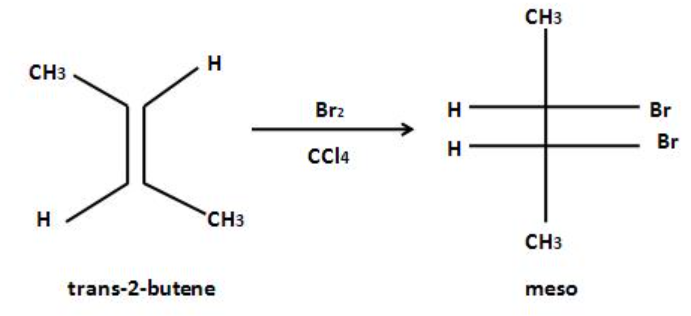
The number of stereoisomers obtained by bromination of trans$ - 2 - $butene is:
(A) $1$
(B) $2$
(C) $3$
(D) $4$
Answer
222.3k+ views
Hint: The form of isomerism in which molecules have the same molecular formula and also the same sequence of bonded atoms but a different three-dimensional orientation of their atoms in space is usually known as stereoisomerism. There are basically two types of stereoisomers i.e. geometrical isomers and optical isomers.
Complete Step by Step Solution:
The addition of a halogen on alkenes is mainly anti-addition. The anti-addition of bromine on trans alkene gives us a meso compound as given below:

To calculate the number of stereoisomers of any compound, we have to first find the number of chiral carbon atoms in the given chemical compound. Then we can calculate the number of stereoisomers that the given chemical compound can show. Stereoisomers are those chemical compounds that have at least one chiral carbon atom, and also have a different arrangement of atoms having the same chemical formula.
The chiral carbon atoms can be defined as those carbon atoms in which all the substituents are not the same. These carbon atoms are usually represented with the star at the top. Only the carbon atoms consisting of a single bond can be a chiral carbon atom. One stereoisomer is obtained by the bromination of trans$ - 2 - $butane.
Therefore, option A is the correct answer.
Note: ${2^n}$ is generally used to find the number of stereoisomers where $n$ is the number of chiral carbon atoms in the given chemical compound. Let’s say that a given chemical compound has one chiral carbon atom. Then we will have the value of $n$ as $1$. By putting this value in ${2^n}$. we get $2$. So, the compound will have $2$stereoisomers.
Complete Step by Step Solution:
The addition of a halogen on alkenes is mainly anti-addition. The anti-addition of bromine on trans alkene gives us a meso compound as given below:

To calculate the number of stereoisomers of any compound, we have to first find the number of chiral carbon atoms in the given chemical compound. Then we can calculate the number of stereoisomers that the given chemical compound can show. Stereoisomers are those chemical compounds that have at least one chiral carbon atom, and also have a different arrangement of atoms having the same chemical formula.
The chiral carbon atoms can be defined as those carbon atoms in which all the substituents are not the same. These carbon atoms are usually represented with the star at the top. Only the carbon atoms consisting of a single bond can be a chiral carbon atom. One stereoisomer is obtained by the bromination of trans$ - 2 - $butane.
Therefore, option A is the correct answer.
Note: ${2^n}$ is generally used to find the number of stereoisomers where $n$ is the number of chiral carbon atoms in the given chemical compound. Let’s say that a given chemical compound has one chiral carbon atom. Then we will have the value of $n$ as $1$. By putting this value in ${2^n}$. we get $2$. So, the compound will have $2$stereoisomers.
Recently Updated Pages
JEE General Topics in Chemistry Important Concepts and Tips

JEE Extractive Metallurgy Important Concepts and Tips for Exam Preparation

JEE Atomic Structure and Chemical Bonding important Concepts and Tips

JEE Amino Acids and Peptides Important Concepts and Tips for Exam Preparation

Electricity and Magnetism Explained: Key Concepts & Applications

JEE Energetics Important Concepts and Tips for Exam Preparation

Trending doubts
JEE Main 2026: Application Form Open, Exam Dates, Syllabus, Eligibility & Question Papers

Derivation of Equation of Trajectory Explained for Students

Hybridisation in Chemistry – Concept, Types & Applications

Understanding the Angle of Deviation in a Prism

How to Convert a Galvanometer into an Ammeter or Voltmeter

Degree of Dissociation: Meaning, Formula, Calculation & Uses

Other Pages
NCERT Solutions For Class 11 Chemistry Chapter 7 Redox Reaction

JEE Advanced Marks vs Ranks 2025: Understanding Category-wise Qualifying Marks and Previous Year Cut-offs

Hydrocarbons Class 11 Chemistry Chapter 9 CBSE Notes - 2025-26

Thermodynamics Class 11 Chemistry Chapter 5 CBSE Notes - 2025-26

NCERT Solutions ForClass 11 Chemistry Chapter Chapter 5 Thermodynamics

Equilibrium Class 11 Chemistry Chapter 6 CBSE Notes - 2025-26




